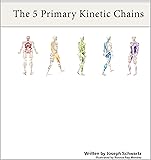
The Five Primary Kinetic Chains - Ebook

The thoracolumbar fascia connects the leg drive of the hip to the shoulder. The contralateral relationship of the gluteus maximus and the latissimus dorsi coil elastic energy into the master fascial spring, thoracolumbar fascia.
Joseph Schwartz • The Five Primary Kinetic Chains - Ebook
nine-phase gait we have: strike, absorb/early-stance, mid-stance, late-stance, push/propulsion, shift, early-swing, mid-swing, late-swing.
Joseph Schwartz • The Five Primary Kinetic Chains - Ebook
The first three kinetic chains, Intrinsic, Deep Longitudinal, and Lateral create the dynamic platform for the power generating kinetic chains: the Posterior and Anterior Spirals.
Joseph Schwartz • The Five Primary Kinetic Chains - Ebook
significant pump systems: cerebrospinal, cardiovascular, lymphatic, and oxygen and carbon dioxide exchange.
Joseph Schwartz • The Five Primary Kinetic Chains - Ebook
The Intrinsic Kinetic Chain is the relationship of the nervous system to breathing. Our breathing apparatus, the mechanism of pressurization systems, affects the autonomic nervous system. “You can’t own your movement until you own your breath.”
Joseph Schwartz • The Five Primary Kinetic Chains - Ebook
Elastic energy is stored in the tissues by two mechanisms. One is the compression occurring as the tissues are coiling into a tight spring.
Joseph Schwartz • The Five Primary Kinetic Chains - Ebook
The body has four
Joseph Schwartz • The Five Primary Kinetic Chains - Ebook
The startle reflex hijacks the nervous system. This up-regulated sympathetic response is a paradox to normal integration of the players of respiration.
Joseph Schwartz • The Five Primary Kinetic Chains - Ebook
This leads to an up-regulated sympathetic nervous system, which results in stress. Breathing mechanics are the first step toward integrated movement.